Dundee, Scotland, United Kingdom
April 11, 2014

Light sensors in plants act as a switch for genetic activity which determines how they adapt to environmental changes, an international research collaboration involving scientists in Argentina, Austria and Scotland including the James Hutton Institute has found.
Researchers from Buenos Aires, Vienna and Dundee have discovered a new gene regulatory pathway in plants which starts in chloroplasts, the light sensors involved in the plant’s photosynthesis. They say their findings hold potential for discovering new regulatory mechanisms of gene expression in all plants and animal organisms, including humans.
The study, a collaborative effort within the “European Network of Excellence on Alternative Splicing”, has now been published in the renowned scientific journal Science.
In order to survive, plants have to respond and adapt very quickly to environmental changes, especially light conditions. The research collaboration has now demonstrated that chloroplasts are key players of this adaptation, helping the plant to immediately respond to new light conditions by controlling the process of `alternative splicing’ in the cell nucleus.
“A substantial part of the chloroplast genome has been transferred to the cell nucleus in the course of evolution so it is no wonder that these two ancient cell compartments have to communicate to ensure that the right proteins are produced at the right time and levels,” said Professor John Brown, from the University of Dundee.
“In this way, the chloroplast and the cell nucleus are an old couple who understand that efficient communication is necessary for a successful relationship.”
In humans as well as in plants, the process of alternative splicing is a major source of genetic diversity. It is estimated that over 90% of human genes, and over 60% of plant genes, are alternatively spliced.
Splicing is a strongly regulated process that depends on a complex sequence code, numerous proteins and an enormously intricate network of interactions among them, which increases the opportunity for exposure to mutations and mis-regulation that can lead to human disease. In fact, new estimations suggest that as many as 50% of human disease-causing mutations affect splicing.
In this new research, scientists studied the Arabidopsis plant to uncover secrets of the gene regulatory network. They found that variations in light conditions affect alternative splicing of a subset of Arabidopsis genes via signals from chloroplasts.
The research exploited a unique system developed in the University of Dundee and the James Hutton Institute by Professor Brown and Dr Craig Simpson to identify and measure changes in alternative splicing of plant genes and in particular changes in key genes under light/dark conditions.
“The importance of alternative splicing in plant and crop science and especially how plants respond to changing environmental conditions will have huge impact on crop production and understanding adaptation in the future” explained Professor Brown, who is based in the College of Life Sciences at Dundee.
The research was led by Alberto Kornblihtt (Argentina) and also involves scientists at the Max F. Perutz Laboratories of the Medical University of Vienna in the lab of Andrea Barta.
The researchers were not only able to show signaling within the cell, but also that a signaling molecule travels through the plant, as light regulation of alternative splicing is also observed in the roots, but only when the communication with the leaves as photosynthetic tissues is not interrupted.
“Since the mechanisms of splicing are conserved in different kingdoms, at some point in the future, scientists will investigate if this process holds true in organelles also found in mammalian cells like mitochondria”, explained Ezequiel Petrillo, one of the research team.
“It is absolutely fascinating to find out how these organelles, which are both of endosymbiotic origin, have learned to manipulate gene expression in the nucleus. In the near future, we want to identify the components involved in this communication pathway and how those signaling molecules take the light message from the photosynthetic tissues to the other parts of the plant.”
Paper:
A Chloroplast Retrograde Signal Regulates Nuclear Alternative Splicing
Petrillo, E., Godoy Herz, M., Fuchs, A., Reifer, D., Fuller, J., Yanovsky, M., Simpson, C., Brown, J., Barta, A., Kalyna, M., Kornblihtt, A. Science, 10 April 2014.